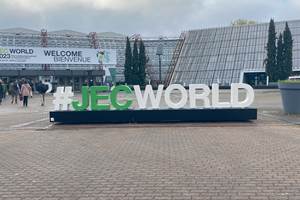Comprehensive material ranges, demonstrator displays support aerospace, automotive targets
JEC World 2025: Hexcel responds to production quality, rate and sustainability needs with the latest composite material portfolios and project highlights.
Source (All Images) | Hexcel
Hexcel (Stamford, Conn., U.S.) demonstrates its latest composite developments for the aerospace and automotive markets. Responding to aerospace industry targets for faster production rates, several key Hexcel aerospace technologies are now configured for automation and out-of-autoclave (OOA) production. In the automotive field, the company has released prepregs targeting cosmetic quality and sustainability.
Automotive
Hexcel showcases HexPly M51, a novel, rapid-curing prepreg developed for hot-in/hot-out press curing of structural composite parts. In addition to shorter curing cycles, HexPly M51 is said to also reduce the requirement for multiple sets of tooling and labor compared with traditional prepreg systems. The system is fully compatible with ATL, AFP and pick-and-place processes.
According to the company, its HexTow continuous carbon fiber remains the preferred solution for advanced aerospace applications. Use of HexTow IM9 24K, for example, maximizes efficiency in primary and secondary aerospace structures. The intermediate modulus fiber compliments the additional standard, intermediate and high modulus fibers in the HexTow range.
Hexcel also promotes its TowPly towpreg range for filament winding applications. The combination of fast cure and high-temperature resistance resin M901 with intermediate modulus IM 24K and 12K carbon fibers make TowPly well suited to filament winding demanding applications in defense, space, urban air mobility (UAM) and civil aircraft markets.
Hexcel also recently expanded its core portfolio, adding the nonmetallic Flex-Core HRH-302 mid-temperature product to its honeycomb range. Developed to offer a thermal management solution to the aerospace industry, HRH-302 is highly conformable and well suited to the complex curvatures and increasing heat loads found in next-generation aircraft nacelles. Certification is currently underway, with Hexcel expecting this material to be a key enabler in future UAM and engine programs.
In addition, Hexcel is highlighting how its latest liquid compression molding (LCM) products are able to deliver improved mechanical performance in structural aerospace components produced with infusion, RTM or C-RTM processes without the investment in autoclaves. HiFlow 1078-1 epoxy resin, in combination with HiTape carbon fiber reinforcement and HiMax carbon fiber noncrimp fabrics, reportedly provides a cost-effective OOA process route for primary aircraft structures. Specially developed for continuous mixing processes, the resin can be accurately monitored by inline mixing equipment thanks to optimized viscosity at process temperatures.
HexShape, a new range of 3D shaped textiles, aims to meet market demand for complex parts. These textiles can be made from various raw materials such as carbon, quartz and glass fibers and can be used in a HexPly format or in combination with HiFlow liquid resins.
Hexcel also features its HexBond adhesives range in a dedicated zone at JEC World. This range gathers the whole scope of adhesives formats (such as adhesive films, pastes, primers and surface films including M98 and others) that complete the global composite package Hexcel provides. The company sees a strong integration of its adhesives in a number of new and legacy aerospace programs. It offers an adhesive range completely compatible with HexPly prepregs to deliver long-lasting reliability and optimal mechanical performance.
Other aerospace highlights at Hexcel’s booth include:
- An aerospace demonstrator component manufactured with unidirectional (UD) carbon fiber-reinforced PEKK. The HELUES project featured partners Christian Karl Siebenwurst GmbH & Co. KG, New Materials Bayreuth GmbH, Airbus Helicopters Deutschland and Hexcel, and has developed a novel process to create an A320 door component using a single layer of UD carbon fiber/PEKK and one-step overmolding of carbon fiber/PEKK ribs in just 4 minutes.
- HexPly M51 parts developed by GKN and Duqueine Group.
- A HexPly M91/IM8 propeller blade manufactured by FACC for the Archer eVTOL aircraft.
- A HexFlow RTM HF640 gutter component and a HiTape/HiFlow1078-1 component created for the NEWS project.
Automotive
Specifically for automotive, Hexcel is launching HexPly M949 cosmetic finish prepreg that has been formulated to provide carbon fiber interior and exterior parts free of white spots and surface pinholes. Its long out-life and toughened epoxy matrix meet automotive cosmetic quality targets after autoclave or press molding cure, with components delivering a 150ËšC glass transition temperature without post-curing.
HexPly M949 is available in a range of traditional automotive fabric styles and is fully compatible with HexPly XF3 surface film for painted parts. Attendees can observe the surface finish achieved using this material on a displayed automotive part demonstrator.
Hexcel also continues to embrace the challenge to develop more sustainable materials and shows a HexPly product that uses a recycled carbon fiber veil to optimize a molded component’s surface finish while also significantly reducing the environmental impact of the part.
As well as PrimeTex and HiMax reinforcements that are used in a range of automotive structural and aesthetic applications, on display is an engine sleeve that has been filament wound for electric vehicle specialist RIMAC using TowPly towpreg made with intermediate modulus IM10 carbon fiber. According to Hexcel, the strength of IM10 carbon fiber enables end users to increase the efficiency of high-speed e-engines.
Visit Hexcel at Booth H57 in Hall 5.
Related Content
Innovation Award finalists revealed for JEC World 2024
Returning to the international composites trade show are the Innovation Awards, representing up to 33 finalists in 11 categories that highlight composites innovation excellence and fruitful collaborations.
Read MorePremier Composite Technologies, Sicomin support Holy Mosque Mataf extension project
The Grand Mosque’s 216,800-square-meter Mataf ceiling demonstrates the architectural possibilities when using composites.
Read MoreJEC World 2024 preview
The world’s largest composites industry trade event returns to Paris, France, March 5-7, 2024, featuring exhibits, awards, conference programming and more.
Read MoreFlax fiber composite innovations, circularity services
JEC World 2024: Flax fiber producer Groupe Depestele and sustainable composites company Greenboats demonstrate flax fiber materials, demonstrators and product offer Circular Structures.
Read MoreRead Next
Hexcel core supports Boeing’s development of the MQ-25 Stingray
HRH-302 honeycomb core material, currently under evaluation for use around the UAV’s high-temperature exhaust nozzle, could considerably extend its range.
Read MoreRöchling and partners iterate thermoplastic composite convertible roof beam
Röchling Automotive, Mercedes-Benz, Envalior and Valmet replaced traditional magnesium with composites, achieving a more seamless, lightweight structural design that opens opportunities for other vehicle applications.
Read MoreCeramic matrix composites: Faster, cheaper, higher temperature
New players proliferate, increasing CMC materials and manufacturing capacity, novel processes and automation to meet demand for higher part volumes and performance.
Read More












